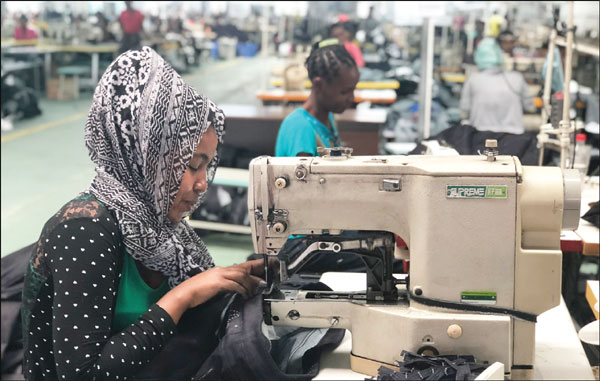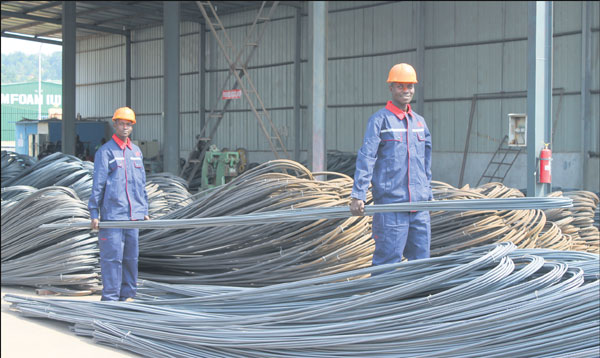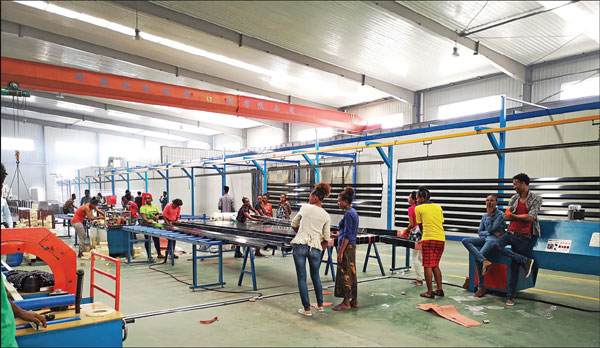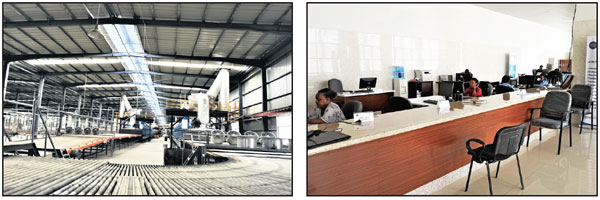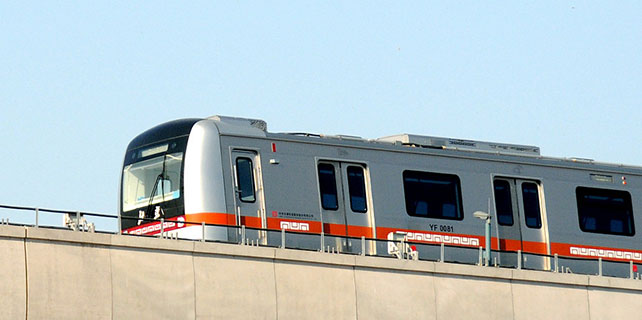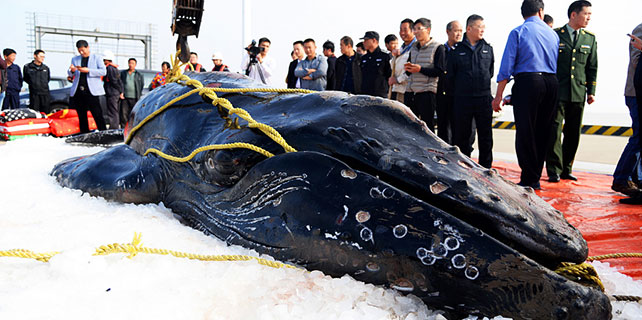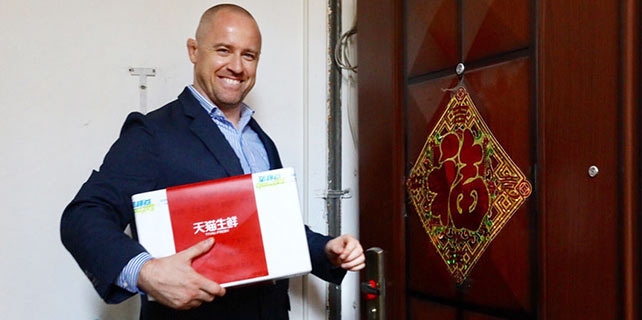Made in Africa
Countries on the continent look to industrial parks to boost investment, promote manufacturing and create jobs
Crowds of people wait each day outside the gates of the Chinese-built Eastern Industry Zone in Dukem, Ethiopia, about 30 kilometers southeast of the capital, Addis Ababa, to submit job applications. Many countries throughout Africa, to deal with the twin problems of unemployed young people and large trade deficits, are building such industrial parks as part of a strategy to attract low-wage manufacturers.
As China's economy moves to higher-value-added products, and because wages there have increased rapidly over the past 10 years, many low-wage manufacturers, especially in the textile and garment industries, are considering moving their production to Africa.
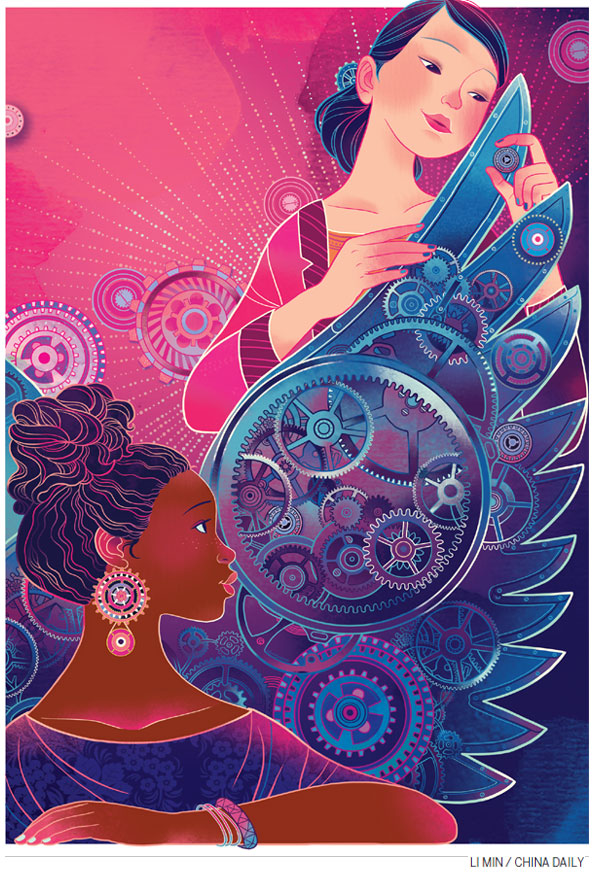
|
Workers at the Lida (Ethiopia) Textiles jeans factory in the Eastern Industrial Zone of Ethiopia. Xiao Xiangyi / China Daily |
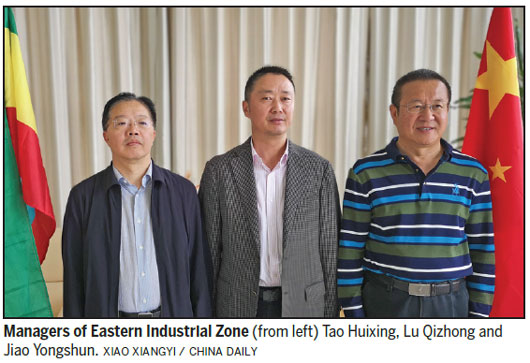
However, low wages won't be enough. Countries will also need to provide a good business environment as well as the infrastructure needed by manufacturers. Industrial parks, often built by Chinese companies, are a key way that African countries are working to create viable manufacturing platforms.
Sub-Saharan Africa is the youngest region in the world, with 43 percent of its population under age 15, according to data from the Kaiser Family Foundation. In the United States, China and Europe, less than 25 percent of the population is so young. In Africa, 200 million people are between the ages of 15 and 24. The continent's population is expected to reach 2 billion by 2050, according to Kaiser.
Jiao Yongshun, vice-director of the Eastern Industrial Zone, says: "The people at the gate come from different parts of the country, and they are looking for a job here. They sit there and discuss which factory gives the best salary and working environment and share other information about working in the park. We used to have many foreign investors who worried about whether they could find sufficient employees here in Ethiopia, but when they actually come here and see those people at the gate, the worries are just gone."
African countries have long been very low in the World Bank's rankings for ease of doing business. The index includes measures of such issues as ease of getting electricity, registering property, getting credit, dealing with construction permits and paying taxes.
But many African countries are making strong efforts to move up the ranks. For example, Rwanda has implemented the highest number of business reforms in the world over the past 15 years, according to the World Bank. In 2017, a record 83 reforms that made it easier to do business were implemented in 36 of 48 economies in sub-Saharan Africa. The World Bank says this is the largest number of reforms ever recorded in any region by its Doing Business report, and represents 31 percent of all reforms implemented globally in the past year.
Justin Yifu Lin, honorary dean of the National School of Development at Peking University and a former World Bank chief economist, is a leading advocate of the argument that African countries should follow the East Asian path of growth that was kicked off by low-wage manufacturing.
"Currently, Africa's economy is based on agriculture and mining, while the manufacturing industry's share in the GDP is declining. African countries have generally recognized the importance of economic restructuring, but steering the economy away from agriculture toward industry is easier said than done," Lin wrote in the magazine China Financial and Economic News in 2016.
"China has established industrial parks, improving infrastructure and the business environment, to reduce transaction costs in them," Lin wrote. "In this process, a gradual capital accumulation and industry upgrade has bolstered the industries' international competitiveness. ... African countries can attract investment through the establishment and development of special economic zones or industrial parks. These would become industry clusters, which can further reduce transaction costs and improve the overall business environment."
Belay Heilemichael, area manager of the Ethiopia Investment Commission, spoke to CGTN about the services provided by the Hawassa Industrial Park, which was built by China Civil Engineering Construction Corp. "There are three objectives," he said. "The first is to generate foreign currency; the second is to implement opportunity; the third is technology transfer. ... The investors should not have to go outside of the park to get services. All services, banking services, even visa service, will be provided there. To ensure success here, the government has a one-stop service center where investors can even get their visas and resident permits."
He added that the companies in the industrial park will be able to generate export revenue of up to $1 billion (860 million euros; £767 million) and hire up to 100,000 people.
Tao Huixing, director of the managing committee of the Eastern Industrial Zone, says companies locate there because the park provides complete utilities and a one-stop service for everything.
So far, the parent company of the Eastern Industrial Zone, Jiangsu Qiyuan Group, has invested around $200 million in the park itself, for infrastructure such as power, water and other connections. Jiangsu Qiyuan, based in Zhangjiagang, near Suzhou, Jiangsu province, is a small, private producer of precision metal products.
In addition, the companies in the park - mostly Chinese companies, though there also are local companies as well as ones from India, the United States and the Netherlands - have invested a further $400 million, Tao says.
Regarding Qiyuan's 2008 decision to begin building the Eastern Industrial Zone, Tao says: "A lot of China's low-wage industry will move here. Formerly in China, wages were very low, but now they are quite high. For some labor-intensive industries, it is very difficult to survive because of the increased labor cost. Here, wages are much, much lower - less than 10 percent of Chinese wages."
Ethiopia has about 45 million people of prime working age, between 18 and 50, he says.
"About 10 years ago, the economy of China was already very big. We encountered many trade restrictions limiting exports to Europe and America, especially in textiles, garments, televisions and some tech products. In these circumstances, the Chinese government said that if you all stay in China, then it will be more difficult. Labor costs have increased, so you should find a new place overseas," Tao says.
"Chinese companies are experienced in these things, because at an early stage of our opening-up, we also did things like this. In the early '80s, the Chinese government created business-friendly policies and encouraged Chinese companies to expand exports. This policy had a very good effect. After five or six years, Chinese companies had a lot of foreign currency and could use it to import advanced production machinery from Europe, America and Japan," he says.
China Daily recently visited five Chinese manufacturers in Ethiopia that illustrate the opportunities and challenges companies are finding there and throughout Africa. Companies making shoes and bluejeans are prototypical low-wage manufacturers, though the shoe factory exports its products and the jeans factory targets the local market. Factories that make glass, ceramic tiles and aluminum window casings build substitutes for imported products needed for Ethiopia's building boom, but their strategies are not so dependent on large numbers of low-wage workers.
Garment manufacturing, which depends on a large, fairly low-skill workforce, is a good example of the kind of industry that finds its comparative advantage in Africa at this time. For example, Lida (Ethiopia) Textile, which is inside the Eastern Industrial Zone, makes bluejeans that are sold in the markets of Ethiopia. The factory began production in September 2017 and was already profitable by November, says Liu Jianxun, the factory director. He says that although the jeans reduce Ethiopian imports, many of the raw materials, especially cotton, must still be imported from China.
Similarly, Dongguan Huajian Group, a large Chinese shoemaker, built a shoe factory and industrial park in Addis Ababa. The company now employs 6,000 Ethiopian workers and plans to expand to 15,000 soon, and possibly to 100,000 eventually.
Glass manufacturing reduces Ethiopia's dependence on imports for use in its building boom. But making glass requires highly experienced management, a large investment in equipment and a more skilled workforce, according to Liu Jun, sales and marketing manager of Ethiopia Hansom International Glass Co, which is located in Addis Ababa and is a subsidiary of CGC Overseas Construction Group.
"If the electric power goes down for even seven minutes, the machinery can be destroyed because the flow of cooling water is stopped. So we have five backup generators. There are many cement factories in Ethiopia. If a problem happens, they just stop. But glass factories are different. Here we run 24 hours a day, every day. Within five years, we have not stopped for even one minute," Liu says.
"Before they came here, our Chinese workers worked in glass factories. They had 10 to 20 years' experience. Local workers just have one or two years' experience, maybe five years," says Liu, adding that there are around 80 Chinese employees and 250 Ethiopians.
Hansom is the only glass manufacturer in Ethiopia, but its profits are not very high because the government tells the company it needs to control its prices, Liu says.
Similarly, Huajia Aluminum produces window frames for the local market. Cai Jinfeng, the company factory's manager, says: "When we first came to Addis Ababa several years ago, many buildings in the city had empty holes in the wall for windows. So we decided to open an aluminum factory instead of making plastic tubes like our mother company in China. The factory started to produce a year ago and is just starting to make a profit. Most of the raw materials are imported from China. We have only 10 to 15 percent Chinese employees; the rest are Ethiopian workers."
Not all companies have found the going easy.
The Diyuan ceramics factory, in the Eastern Industrial Zone, produces ceramic tiles intended to substitute for imports in the many buildings going up around the country. The company began production around two years ago and continued for a year and a half, but the environmental protection bureau of the local government made it cease production, according to Zhou Jingfeng, the factory's director.
"We have invested $3 million in pollution control. We can meet both Chinese standards and Ethiopian standards, but the local government, not the Ethiopian federal government, just won't let us produce, because local residents complain to them when they see our (coal-fired) chimneys," Zhou says. "In the yard of the ceramics factory, 104 containers have remained locked for more than 15 days. Each container is charged $100 a day, so we are suffering a great loss."
The transition to manufacturing-based growth is just getting started in Africa. For example, in Ethiopia in 2015, agriculture still accounted for 85 percent of employment, 90 percent of foreign currency earnings and about 39 percent of GDP, according to Ethiopian government data.
There is an ongoing debate about whether the recent economic successes in Africa were caused by higher commodity prices or by a transition to an economy based on manufacturing-led growth. A World Bank report from 2017 concluded: "Over the past decade and a half, sub-Saharan Africa has experienced rapid economic growth at an average annual rate of 5.5 percent. But since 2008, the share of manufacturing in GDP across the continent has stagnated at around 10 percent. This calls into question as to whether African economies have undergone structural transformation - the reallocation of economic activity across broad sectors - which is considered vital for sustained economic growth in the long run."
One factor helping the transition is new Chinese-built infrastructure - roads, railways, dams, water and electrical systems - that make business possible. Ahmed Shide, the minister of Ethiopia's Government Communication Affairs Office, told Xinhua in May: "Learning from the Chinese economic growth experience, Ethiopia will have about 15 industrial parks by June, most of them built with Chinese money and expertise. We have also heavily invested, with Chinese assistance, in road, rail and air infrastructures to alleviate transportation problems for Ethiopia's exports."
"The Addis Ababa-Djibouti rail line, which recently started commercial operations, has cut transportation time for Ethiopian goods to the Djibouti ports from two days to 10 hours, giving a leg up for Ethiopia's economic dreams of becoming a light manufacturing hub in Africa and a middle-income economy by 2025," he said. "Ethiopia has seen China's success in having an efficient and effective infrastructure to facilitate exports from industrial parks, and as such is building a 'development belt' to copy the Chinese success story."
Shide said about half of the industrial parks will be located along the rail line.
Tao, of the Eastern Industrial Zone, says that changing an economic development strategy takes time. "In China, we have industrial parks everywhere, especially in Jiangsu. We know how to build them. But when we started negotiations with the Ethiopian ministries in 2008, they had no idea what an industrial park is. They did not have any laws about this.
"Ten years ago, the investors who came here thought the risk was very low government efficiency. What took three days in China would take maybe a month in Ethiopia. But things have changed. Now we don't even think about government efficiency," he says.
Huo Jiangtao, assistant dean of the Institute for African Studies at Guangdong University of Foreign Studies, told Xinhua in June: "China's investment in Africa has totaled more than $100 billion, and the country has built more than 20 economic zones on the continent, with more planned."
By the end of last year, Chinese companies had built 75 zones for economic and trade cooperation in 24 countries along the routes of the Belt and Road Initiative, contributing more than $2.2 billion in taxes and creating almost 210,000 local jobs by the end of 2017, according to Xinhua.
"We actually want to see more competition from local Ethiopian companies," says Lu Qizhong, director of the Eastern Industry Zone. "For example, they have invested in cement factories, so their production capacity has increased rapidly. Ten years ago, their annual imports of cement were 3 million tons per year. Now their capacity has reached 21 million tons, so they have the potential to export."
Tao says: "We want to teach the local people so, some years later, these people can also be business operators. They can set up their own business. China was also like this in the 1980s. Young people working in factories got some experience and learned how to produce, then they went out of the factories and set up their own workshops.
"Also, we don't want to forget our old friends who helped us," he adds. "In the 1960s and '70s, China got a lot of support from African countries. When friends support you in your difficult time, you cannot forget them."
Contact the writers at davidblair@chinadaily.com.cn.
|
Workers at the steel products factory in Tian Tang Industrial Park in Mukono, Uganda. Provided to China Daily |
|
Workers at Huajia Aluminum in the Eastern Industrial Park. David Blair / China Daily |
|
The empty production line at Diyuan ceramics and the one-stop service center in Eastern Industrial Park. David Blair / China Daily |
(China Daily Africa Weekly 09/14/2018 page1)



